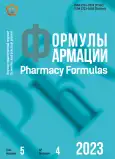The antiarrhythmic activity of amino acid-containing derivatives of 1,4-naphthoquinone
- Authors: Napalkova S.M.1, Buyuklinskaya O.V.1
-
Affiliations:
- Saint Petersburg State Chemical and Pharmaceutical University
- Issue: Vol 5, No 4 (2023)
- Pages: 10-15
- Section: Pharmaceutical Sciences
- URL: https://journals.rcsi.science/PharmForm/article/view/254010
- DOI: https://doi.org/10.17816/phf626911
- ID: 254010
Cite item
Full Text
Abstract
In recent times, the issue of cardiac arrhythmia disturbances has garnered increasing attention from researchers. Pharmacotherapy continues to be the primary method for treating rhythm disturbances; however, its effectiveness is often limited due to the common side effects associated with many antiarrhythmic drugs, among which negative inotropic action plays a significant role. One direction in the development of antiarrhythmic agents involves the targeted search for new drugs among agents with metabolic effects. The aim of this study was to investigate the antiarrhythmic activity using models of occlusion and reperfusion arrhythmias in cats, aconitine arrhythmias in rats, and calcium chloride ventricular fibrillation in rats of five original amino acid-containing derivatives of 1,4-naphthoquinone, synthesized at the Lviv Polytechnic Institute under the guidance of Ph.D. A.P. Kartoflitska. The conducted research indicated that the studied compounds exhibit antiarrhythmic effects. The enhancement of the antiarrhythmic activity occurred primarily in those arrhythmia models where metabolic disorders play a significant role in the pathogenesis.
Full Text
##article.viewOnOriginalSite##About the authors
Svetlana M. Napalkova
Saint Petersburg State Chemical and Pharmaceutical University
Author for correspondence.
Email: svetlana.napalkova@pharminnotech.com
ORCID iD: 0000-0002-9216-8673
SPIN-code: 7311-2841
D.Sc. in Biology, Professor, Professor at the Department of Pharmacology and Clinical Pharmacology
Russian Federation, Saint PetersburgOlga V. Buyuklinskaya
Saint Petersburg State Chemical and Pharmaceutical University
Email: olga.buyklinskaya@pharminnotech.com
ORCID iD: 0000-0002-4453-1079
SPIN-code: 9691-6490
Dr.Med.Sci, Professor at the Department of Pharmacology and Clinical Pharmacology
Russian Federation, Saint PetersburgReferences
- Miller O.N., Syrov A.V., Doshchitsin V.L., Pavlova T.V., Tarasov A.V. Clinical guidelines and expert opinion on the use of antiarrhythmic drugs in actual practice // Consilium Medicum. - 2019. - Vol. 21. - N. 5. - P. 43-50. doi: 10.26442/20751753.2019.5.190328. (In Russ).
- Jones, B., & Burnand, C. Antiarrhythmic drugs. Anaesthesia & Intensive Care Medicine, 2021; 22(5): 319-323.
- Nanasi P.P., Pueyo E., Virag L. Perspectives of Antiarrhythmic Drug Therapy: Disappointing Past, Current Efforts, and Faint Hopes. Frontiers in Pharmacology, 2020; 11: 1116.
- A.c. SSSR 1690339. N-(3-khloro-1,4-naftokhinonil-2)-2-D,L-asparaginovaya kislota, proyavlyayushchaya kardiostimuliruyushchie svoistva / A.P. Kartoflitskaya, V.T. Kolesnikov, V.S. Zybin, N.M. Mitrokhin, Yu.V. Burov, N.S. Diogenova, A.A. Guzova; zayavl. 30.03.1990, opubl. 20.09.1999; Byul. № 42. (In Russ).
- Marakhovsky Yu.Kh. Clinical evaluation of amino acids as drugs: separate systematized ana-lytical sketches. Recipe. 2012;4(84):124-140. (In Russ).
- Shenasa, M., Shenasa, MA., Smith, M. (2020). Class I Antiarrhythmic Drugs: Na+ Channel Blockers. In: Martínez-Rubio, A., Tamargo, J., Dan, G . (eds) Antiarrhythmic Drugs. Current Cardiovascular Therapy. Springer, Cham. https://doi.org/10.1007/978-3-030-34893-9_2
Supplementary files







